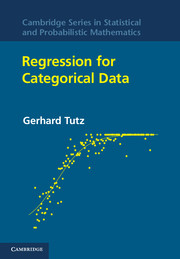Book contents
- Frontmatter
- Contents
- Preface
- 1 Introduction
- 2 Binary Regression: The Logit Model
- 3 Generalized Linear Models
- 4 Modeling of Binary Data
- 5 Alternative Binary Regression Models
- 6 Regularization and Variable Selection for Parametric Models
- 7 Regression Analysis of Count Data
- 8 Multinomial Response Models
- 9 Ordinal Response Models
- 10 Semi- and Non-Parametric Generalized Regression
- 11 Tree-Based Methods
- 12 The Analysis of Contingency Tables: Log-Linear and Graphical Models
- 13 Multivariate Response Models
- 14 Random Effects Models and Finite Mixtures
- 15 Prediction and Classification
- A Distributions
- B Some Basic Tools
- C Constrained Estimation
- D Kullback-Leibler Distance and Information-Based Criteria of Model Fit
- E Numerical Integration and Tools for Random Effects Modeling
- List of Examples
- Bibliography
- Author Index
- Subject Index
6 - Regularization and Variable Selection for Parametric Models
Published online by Cambridge University Press: 05 June 2012
- Frontmatter
- Contents
- Preface
- 1 Introduction
- 2 Binary Regression: The Logit Model
- 3 Generalized Linear Models
- 4 Modeling of Binary Data
- 5 Alternative Binary Regression Models
- 6 Regularization and Variable Selection for Parametric Models
- 7 Regression Analysis of Count Data
- 8 Multinomial Response Models
- 9 Ordinal Response Models
- 10 Semi- and Non-Parametric Generalized Regression
- 11 Tree-Based Methods
- 12 The Analysis of Contingency Tables: Log-Linear and Graphical Models
- 13 Multivariate Response Models
- 14 Random Effects Models and Finite Mixtures
- 15 Prediction and Classification
- A Distributions
- B Some Basic Tools
- C Constrained Estimation
- D Kullback-Leibler Distance and Information-Based Criteria of Model Fit
- E Numerical Integration and Tools for Random Effects Modeling
- List of Examples
- Bibliography
- Author Index
- Subject Index
Summary
In several chapters we discussed parametric regression modeling for a moderate number of explanatory variables based on maximum likelihood methods. In some areas of application, however, the number of explanatory variables may be very high. For example, in genetics, where binary regression is a frequently used tool, the number of predictors may be even larger than the number of predictors. In this “p > n problem” maximum likelihood and similar estimators are bound to fail. Typical data of this type are microarray data, where the expressions of thousands of predictors (genes) are observed and only some hundred samples are available. For example, the dataset considered by Golub et al. (1999a), which constitutes a milestone in the classification of cancer, consists of gene expression intensities for 7129 genes of 38 leukemia patients, from which 27 were diagnosed with acute lymphoblastic leukemia and the remaining patients acute myeloid leukemia.
In high-dimensional problems the reduction of the predictor space is the most important issue. A reduction technique with a long history is stepwise variable selection. However, stepwise variable selection as a discrete process is extremely variable. The results of a variable selection procedure may be determined by small changes in the data. The effect is often poor performance (see, e.g., Frank and Friedman, 1993). Moreover, it is challenging to investigate the sampling properties of stepwise variable selection procedures.
An alternative to stepwise subset selection is regularization methods. Ridge regression is a familiar regularization method that adds a simple penalty term to the log-likelihood and thereby shrinks estimates toward zero.
Information
- Type
- Chapter
- Information
- Regression for Categorical Data , pp. 143 - 180Publisher: Cambridge University PressPrint publication year: 2011
